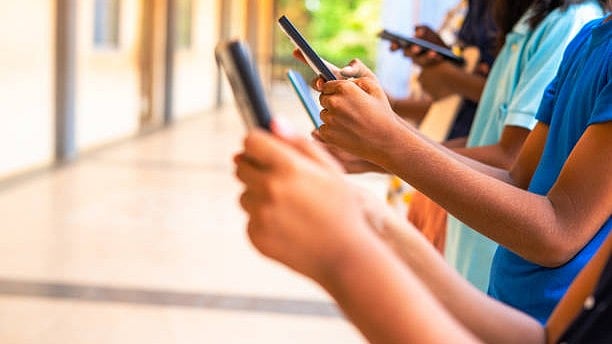
Image for representational purposes.
Credit: iStock Photo
The laptop and smartphone are quietly replacing the gun and stone in Kashmir. In homes once haunted by uncertainty and anger, young men and women now sit before glowing screens — writing code, editing videos, designing logos, or uploading reels. Across the Valley, a new generation is logging into India’s digital economy — freelancing, coding, creating content, and selling online — and finding hope where conflict once ruled.
With smartphones in their hands and steady Internet at their fingertips, Kashmiri youth are earning in rupees and dollars, not slogans. From downtown Srinagar to remote Kupwara, they are discovering livelihoods once unimaginable in the Valley’s long years of turmoil. It is a quiet digital uprising — powered by Wi-Fi, not warfare.
The transformation has been slow but steady. A decade ago, curfews and shutdowns defined Kashmir’s youth experience. Now, the same generation that grew up under siege is building online careers. The conflict that once dictated their destiny is giving way to connectivity.
Young people who once looked towards government jobs now work with Indian and international clients from their bedrooms. Graphic designers, content writers, app developers, and digital marketers from Kashmir are active on freelancing platforms, earning incomes that rival salaried professionals. Many are self-taught, driven by curiosity, necessity, and the easy access to tutorials on YouTube.
The pandemic years, when remote work became a global norm, accelerated this trend in Kashmir. Internet stability after years of restrictions created a new confidence. Cafés and shared workspaces are springing up in Srinagar, Anantnag, and Baramulla. A culture of self-reliance is emerging where dependency and despair once dominated.
Equally remarkable is the rise of digital creators. Kashmiri youth are finding their voice on YouTube, Instagram, and other platforms — telling their own stories, monetising their art, and connecting to audiences far beyond the Valley. From travel vloggers capturing unseen corners of Kashmir to musicians releasing original tracks and comedians producing short sketches, social media has become both a stage and a source of income.
A generation that once saw protest as expression is now using video and storytelling as a means of empowerment. Many creators have crossed the 100,000-subscriber mark on YouTube and earn steady monthly income through ads, sponsorships, and collaborations. Others are using Instagram and Facebook for small business marketing — selling traditional crafts, home décor, baked goods, and apparel directly to customers.
For young women, this shift has been especially liberating. Social media has opened up work-from-home possibilities in a conservative environment. Many are managing online boutiques, baking ventures, and crochet stores, while others teach languages and skills through live sessions. Where traditional spaces limited women’s participation, the digital world has created new freedom — economic, social, and creative.
The monetisation of digital content has also introduced a new idea of success in Kashmir — one that does not depend on political patronage or government employment. Influencers now travel to Delhi, Mumbai, Hyderabad and Bengaluru for collaborations, and Kashmiri brands advertise through Instagram creators instead of hoardings. The digital marketplace has blurred the boundaries between Srinagar and the rest of the country, giving youth a sense of belonging to a wider economy.
The change is visible in everyday life. At Srinagar’s cafés, laptops have replaced newspapers, and talk of algorithms has replaced political gossip. Young men once drawn to street protests now discuss app development or camera gear. The desire to be heard remains, but the medium has changed — from street slogans to digital storytelling.
A quiet psychological shift accompanies this economic one. Years of conflict had created a deep sense of helplessness among the youth, with many seeing anger as their only expression of agency. But the digital economy has opened new doors. Through freelancing or content creation, they can now assert control over their lives, build audiences, and engage with the world on their own terms.
This transformation is not without challenges. Frequent power cuts, poor infrastructure in rural districts, and social stigma around “online work” persist. Many young freelancers still hide their income from sceptical elders who ask when they will find a “real job”. Connectivity disruptions, too, remain a constant anxiety — every network suspension translates into a professional setback. Yet despite these hurdles, the optimism is palpable.
For the first time in decades, a significant section of them is interacting daily with peers, clients, and collaborators across states and countries — on professional, not political, terms. The Internet, once seen as a threat or a surveillance tool, is increasingly becoming an enabler of opportunity.
The change is subtle but profound. In the same downtown lanes that once echoed with angry slogans, co-working spaces now hum with the quiet clatter of keyboards. Where stone-pelting once marked rebellion, editing software and payment notifications now mark progress. The idea of dignity — long eroded by conflict and dependency — is being rediscovered through digital empowerment.
There is no single leader or movement driving this transformation, no visible banner or rally. It is a revolution of individuals — each choosing creativity over confrontation, ambition over anger. Every Kashmiri youth who sells a design online, uploads a monetised video, or codes for a client outside the Valley adds a pixel to a larger picture of change.
Kashmir’s story, once dominated by images of barbed wire and bunkers, is slowly acquiring a new vocabulary — one of startups, subscribers, and self-employment. The Wi-Fi signal has become a new symbol of hope.